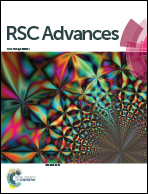Two physical strategies to reinforce a nonmetallic photocatalyst, g-C3N4: vacuum heating and electron beam irradiation†
Abstract
Herein, we demonstrated two physical strategies, namely, vacuum heating and electron beam irradiation, to reinforce a nonmetallic photocatalyst, g-C3N4. These two post-treatments also improved the visible light absorption properties of g-C3N4; however, electron beam irradiation was more destructive, and it caused a determined change in the chemical bonds and band structure of the compound. According to the post-processing parameters mentioned in this article, vacuum heating (38 ± 2 mTorr for 4 days at 200 °C) enhanced the photocatalytic efficiency of the original g-C3N4 by 2.5 times, whereas electron beam irradiation (760 kGy at 1.8 MeV and 8 mA s−1) improved it by 4.5 times. Finally, the post-treated photocatalysts were stable during photocatalytic oxidation, which is important for practical applications.


 Please wait while we load your content...
Please wait while we load your content...